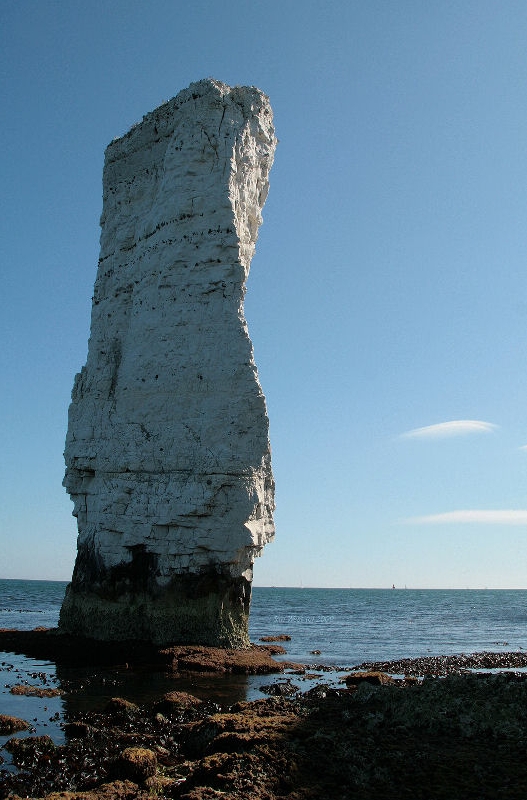
This magnificent sea stack, called Old Harry Rock, stands near the eastern end of the Jurassic Coast of England. This picture is from Dr. Ian West's webpage, which is packed with geological information about this area. For another amazing formation on the Jurassic Coast, see the top of my January 2012 diary.
Next to Old Harry Rock is Old Harry's Wife, shown here:
Again this image is from Dr. Ian West's webpage.
But who, you ask, is Old Harry? One legend says it was Harry Paye, an infamous pirate from Dorset who later became a commander, leading naval raids along the coast of France and Spain, burning two cities to the ground and taking many hostages. This legend says he stored his contraband nearby. But another legend says that the Devil himself (traditionally known euphemistically as "Old Harry") had a sleep among these rocks. Indeed, Old Harry Rock is also known as the Devil's Rock.
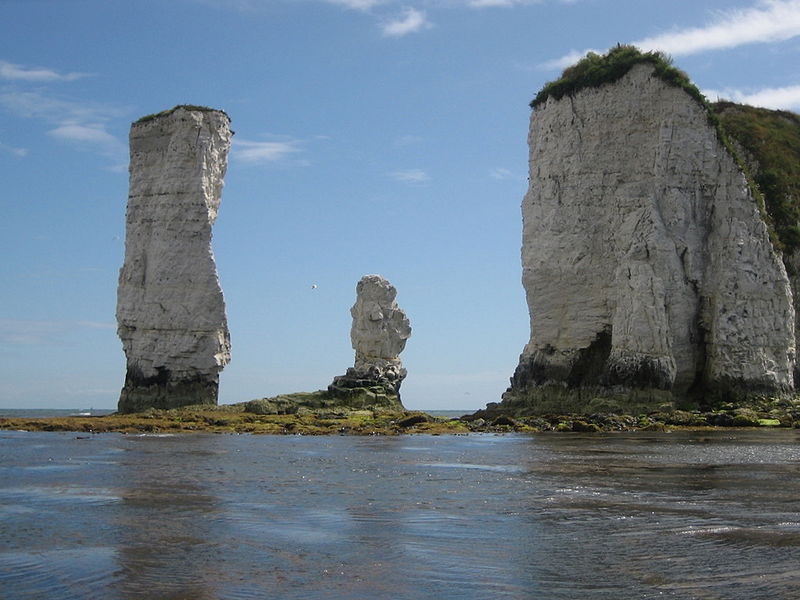
Above is a nice view of Old Harry's Rock, Old Harry's Wife and the cliff on the shoreline, known as St. Lucas' Leap. Why that name? In 1910, W. M. Hardy wrote:
It was close by, at St. Lucas's Leap, that a pair of pedigree greyhounds belonging to a certain squire at Studland, while coursing a hare, are said to have leaped clean over the cliff and have been dashed to pieces, the name St. Lucas being afterwards given to the spot where the tragedy occurred to commemorate the name of one of the favourite hounds which perished so suddenly and tragically. It was said that the old gentleman did not long survive the disaster, as he was so greatly attached to the dog and its fortunes.More recently, in 2009, a dog chasing a rabbit ran off this 30-meter cliff, landed in the sea, and was rescued by the crew of a yacht that happened to be nearby! The breed of dog? Springer spaniel.
The above picture was taken by "Cmcqueen" and can be found on the Wikipedia article about the Old Harry Rocks. The anecdotes are from Dr. Ian West's webpage.
Finally, here's a stunning view of Old Harry through a sea arch:
It looks like an abstract expressionist painting! I got it
here.
February 15, 2012
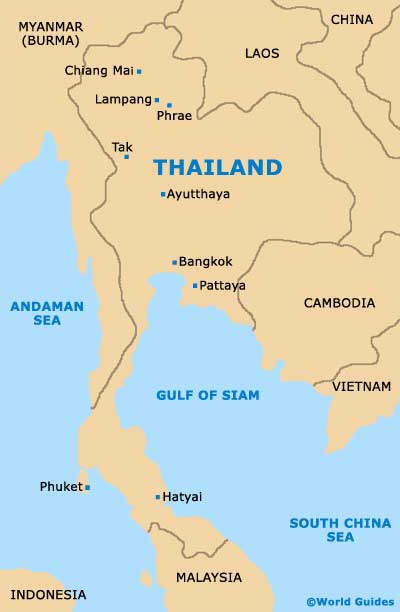
I've been avoiding long plane trips, but unable to resist getting to
know the neighborhood while living here in Singapore. On Friday, Lisa
and I are going to Chiang Mai for a week! That's the main city in
northern Thailand. Bangkok, much bigger, is down south. Singapore is
at the southern tip of Malaysia, not visible here. Luang Prabang, a
town we recently
visited in Laos, is not far from Chiang Mai. And indeed the Lao
language is closely related to Thai, and some of the traditional
architecture is similar. So it may be a bit familiar... though
Thailand is much more prosperous.
February 16, 2012
I've been struggling to understand the history of Southeast Asia. Here's what it looked like around 1300 AD. Chiang Mai, the city I'll be visiting on Friday, was the capital of the Kingdom of Lanna — the purple region. Next to it, in orange, is the larger Sukothai Empire. East of that, in red, is the even larger Khmer Empire, whose capital, Angkor, I've already taken you to: that's the city near the big lake. To the east of that is Champa, a Hindu kingdom that covers much of what's now Vietnam. I saw some great statues from Champa when I visited the city of Huế in Vietnam.
I like the idea of staying in a city surrounded by a wall and a moat. Not that I'll feel safer... just sort of snug. Did you ever read Doris Lessing's novel The Four-Gated City? Well, the old city of Chiang Mai is square, with four main gates. Here's Thapae Gate, on the east. Ever since 1300, the main route into this city has come from the Ping River down Tapae Road through this gate. By now Chiang Mai has expanded beyond its original walls, but this is still the main entrance to the old city.
In Chiang Mai we'll be staying on Ratchadamnoen Road. Every Sunday from 4 pm until midnight this road becomes a huge Walking Street Market. Night markets are common in Asia — and this video, while not very professional, does a great job of conveying the feel of friendly chaos that makes these markets fun! They might seem scary at first, but everyone is completely laid back, so relax and explore: you might see a magician, or a stall selling puzzles of the Buddha, or quail eggs... you never know! I'm really going to miss these markets when I come back to the US. The shopping malls there are neat, clean, and deadly dull.
February 17, 2012
We flew to Chiang Mai and took a preliminary look around.
Though it's the dry season, the city was shrouded in clouds...
The first things that jump out at you are the Buddhist temples, called wats, and the many novice monks dressed in bright orange:
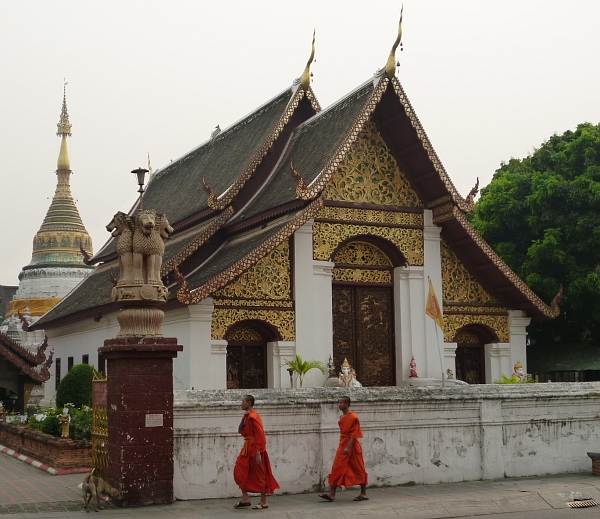
The wats are similar to the Lao ones shown in my January 2012 diary entries, but subtly different in many ways. The stupas seem more prominent, for example — the stupa is the gold-tipped thing in back of the above photo — and they have a rich variety of sculpture:
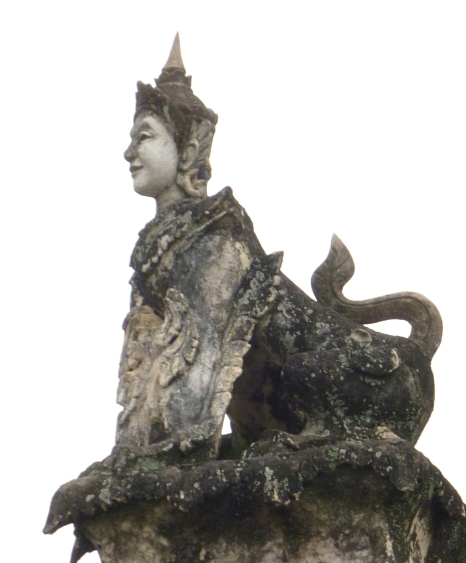
However, as in Laos and Cambodia, Theravada Buddhism rests on an earlier layer of animist religion, so there are little spirit houses all over, especially in front of shops:
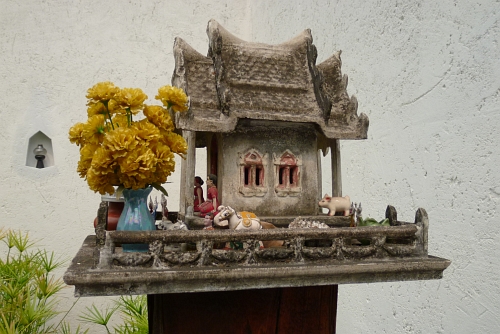
We went east on Ratchadamoen Road to Thapae Gate. Note the typical cloudy Chiang Mai sky:
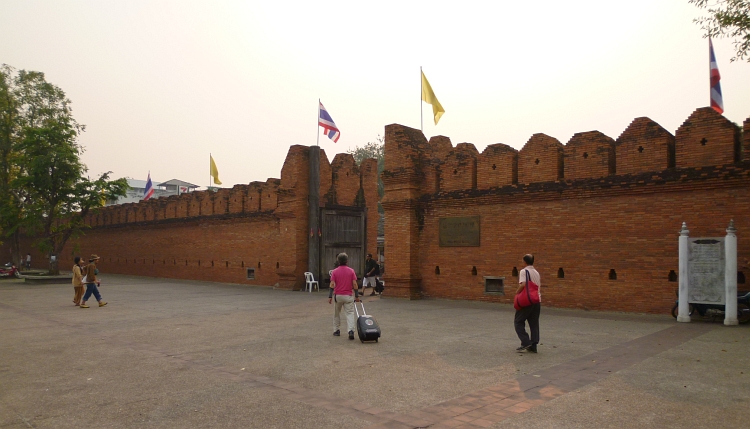
There are in fact not just four gates to the city, but twelve.
But most of these are now roads rather than actual gates, since
in many places the original walls have crumbled and disappeared.
Thapae Gate is the biggest actual gate, but the brickwork here looks
new.
February 18, 2012
I'm becoming fascinated by the snake-like creatures called nāgas
that guard many of the buildings in the wats here. According to the Wikipedia
article:
The Buddhist nāga generally has the form of a great cobra-like snake, usually with a single head but sometimes with many. At least some of the nāgas are capable of using magic powers to transform themselves into a human semblance. In Buddhist painting, the nāga is sometimes portrayed as a human being with a snake or dragon extending over his head. One nāga, in human form, attempted to become a monk; when telling it that such ordination was impossible, the Buddha told it how to ensure that it would be reborn a man, able to become a monk.I showed you some Lao nāgas in my December 28, 2011 diary entry. They play a more prominent role as temple guardians here in Chiang Mai. Here are two at Wat Prasat, a smaller wat behind the big and famous Wat Phra Singh:[...]
Nāgas are believed to both live on Mount Sumeru, among the other minor deities, and in various parts of the human-inhabited earth. Some of them are water-dwellers, living in streams or the mer; others are earth-dwellers, living in underground caverns.
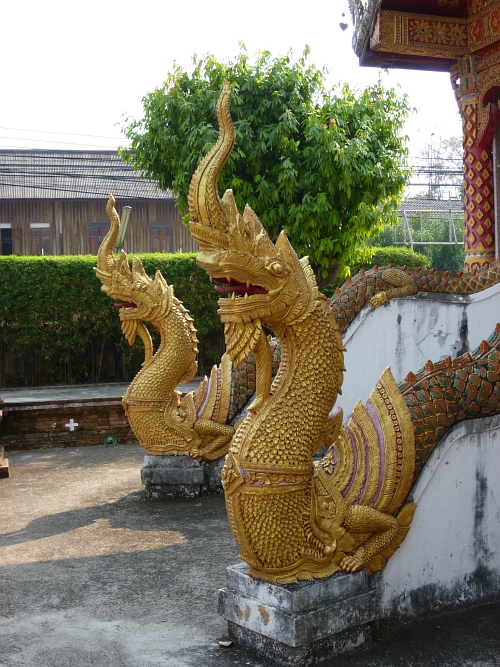
If you look carefully you can see the nāga is emerging from the jaws of another creature! See it? That's a makara!
Ubiquitous among the wat guardians is the mythical serpent, the naga. A denizen of the waters and the underworld, the naga appears on barge boards, eave brackets, and balustrades as well as on arhces over gates, windows and doors. According to some legends, the naga can also take the form of a human.That quote is from this nice little book:On the balustrades, the naga often shares his role with the makara, a crocodilian creature whose open toothy jaws disgorge an irate naga. The makara head sometimes spouts an attenuated elephant trunk, and the neck is usually encircled by three ruffs.
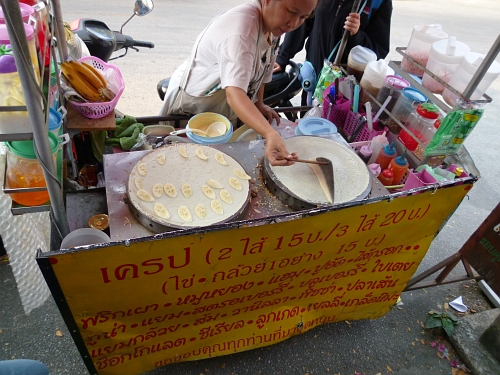
We went out the west gate of the old city. Some of the wall here has been renovated, but some is old:
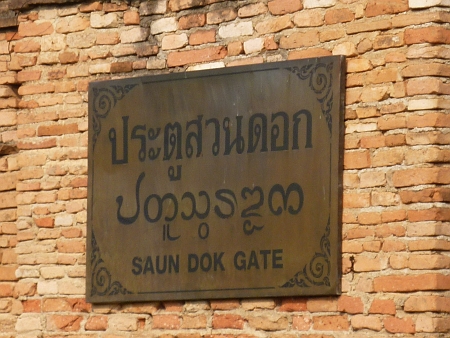
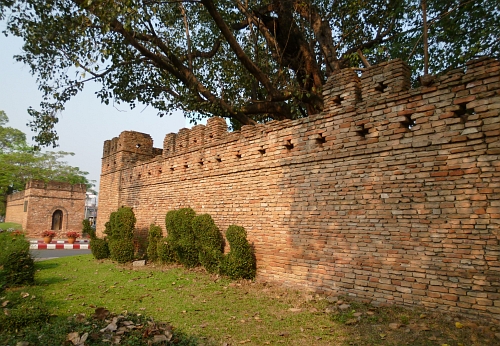
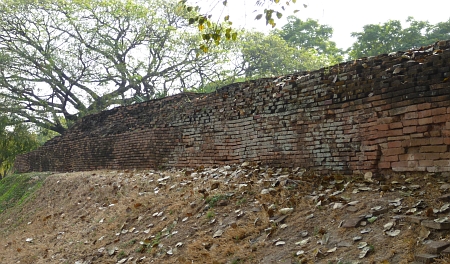
The sign, while new, features the gate's name not only in Thai (on top) and English, but also in the Lanna script that was used here in the old days.
The Saturday walking street market starts at 4 pm on Wualai Road, south of the old part of Chiang Mai. It's less crowded and nicer than the famous Sunday market.
About 200 years ago, the Tai Khoen people living in what's now Burma were defeated by the Lanna Kingdom, whose capital was Chiang Mai. Many silversmiths, blacksmiths and stonemasons were captured and resettled in this part of town. Even now this area is famous for its silver shops. But the market features crafts of all kinds, as well as food and free live music!
Here's a bit of what we saw there:
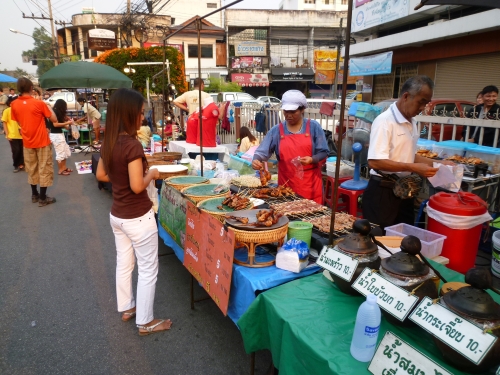
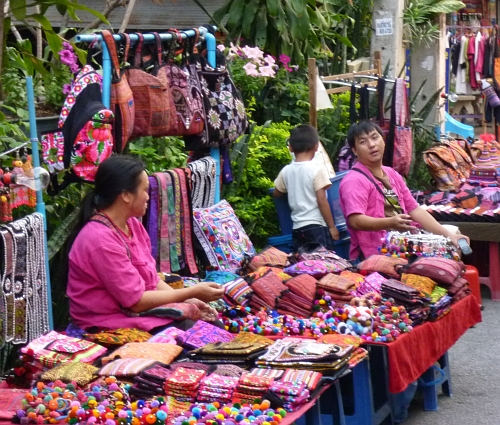
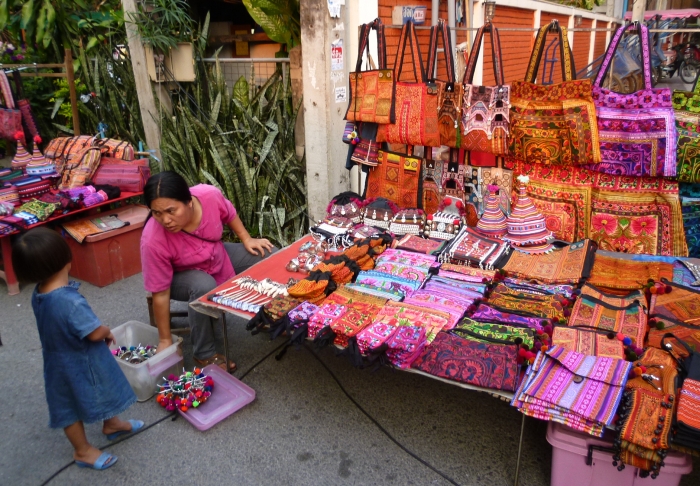
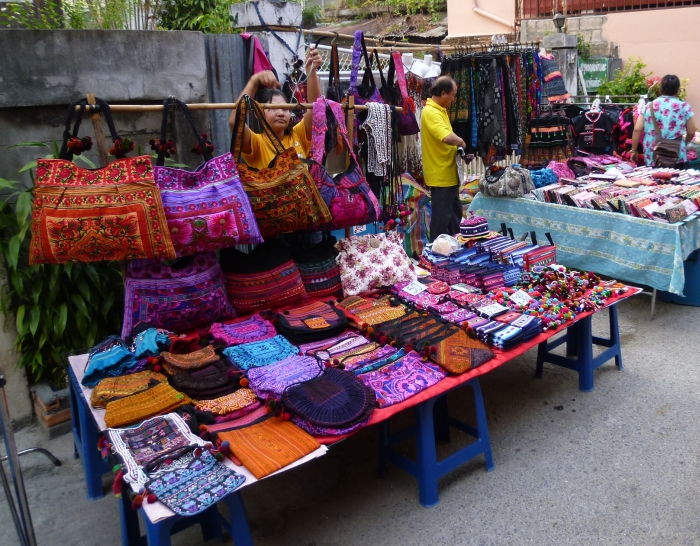
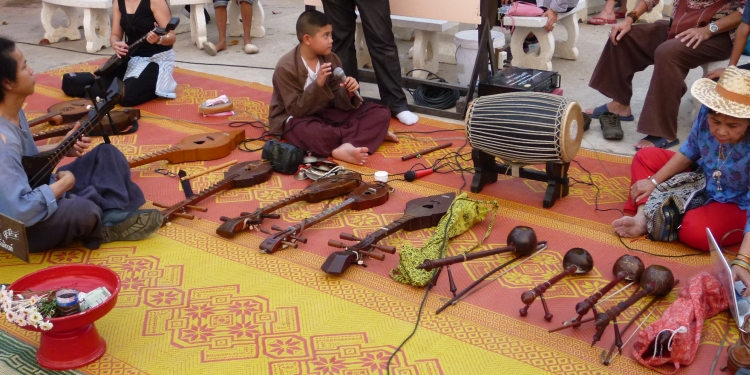
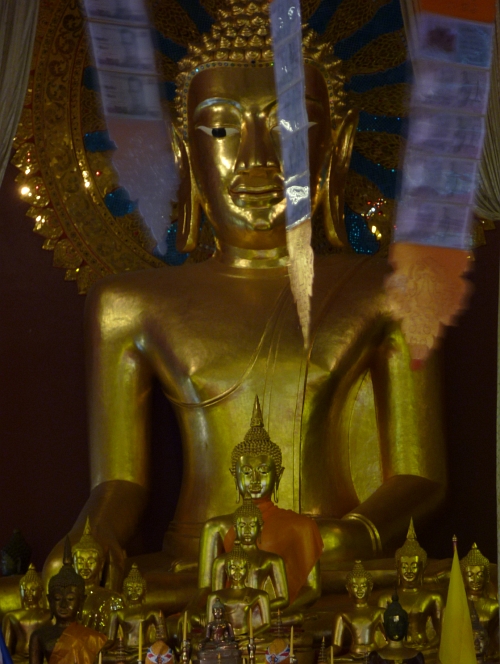
This makes me think of how our self has a model of itself, which has a model of itself, and so on. Elisabeth Schobus said it makes her think of how "the higher self, that is aware of all the lives it has endured, watches benignly all the lives still evolving". In Mahayana Buddhist temples one sometimes sees a row of three statues representing Dipankara, Shakyamuni and Maitreya: the Buddhas of the past, present and future. But in Thailand the Buddhists are mostly Theravadan, and for them the only Buddha is the actual historical guy, as far as I know — though they do tell tales of his past lives. So, I don't understand the symbolism of this Buddha-row.
The gardens feature a Buddha amid tulips — quite unusual, it seems:
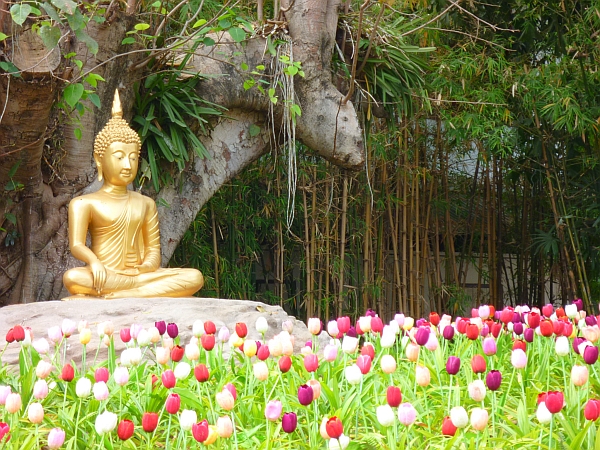
There are also two cute little nāgas in a pond:

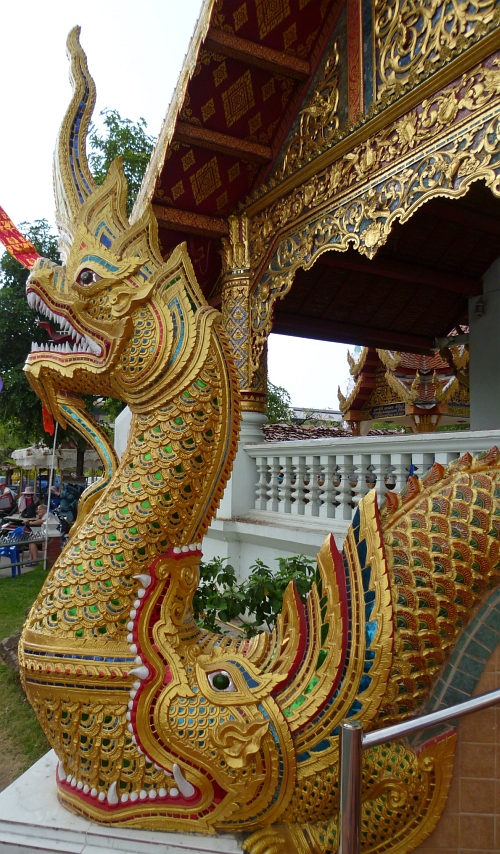
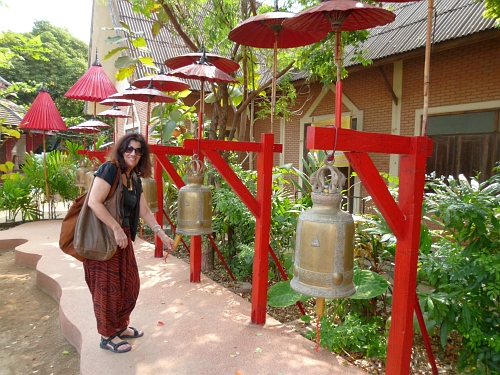
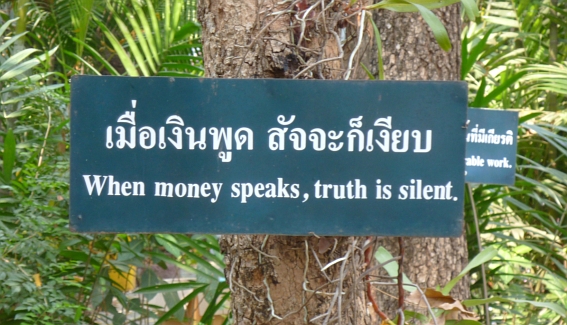
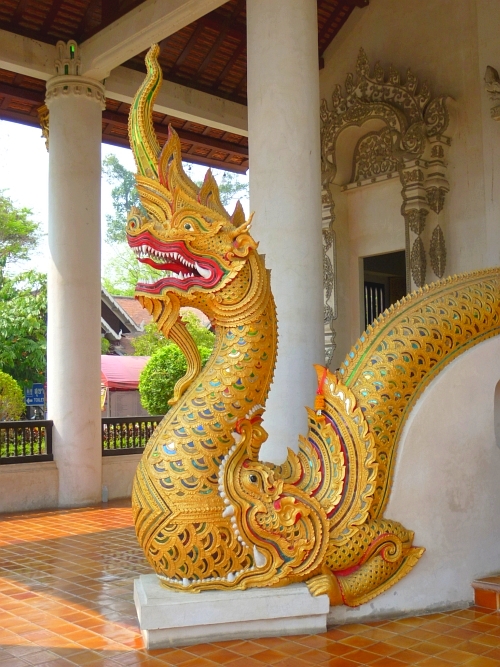

I also saw a mom:
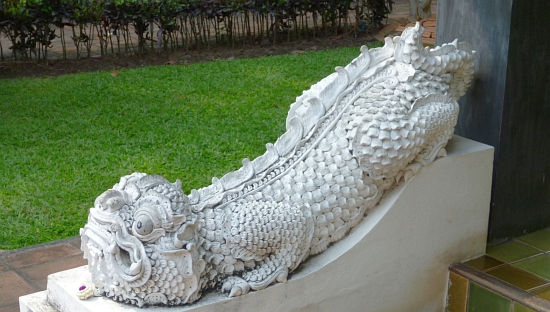
But don't ask "whose mom?" In Thai, "mom" is the name of a mythical aquatic creature with legs. This one looked rather bug-eyed and slow-witted: I thought it was just a kind of larval nāga. Later I saw some more energetic-looking ones.
But the high point of this wat is the enormous stupa out back. Every wat should have a stupa, which is a symbol of Mount Mehru, the center of the universe in Hindu (and then Buddhist) cosmology:
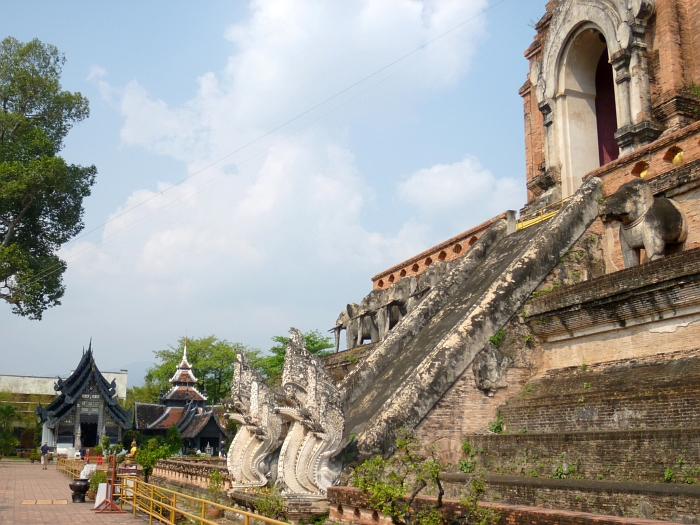
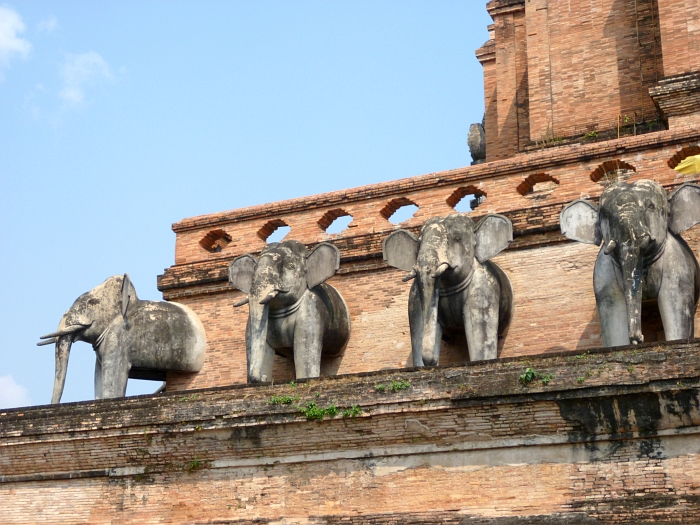
Note the huge stone nāgas at the base of the stupa, and of course the elephants above! There used to be lots of elephants in Thailand, and there are still quite a few.
In the afternoon we headed up to the northeast of the old city. We saw a coffee shop with a sign that raised more questions than it answered:
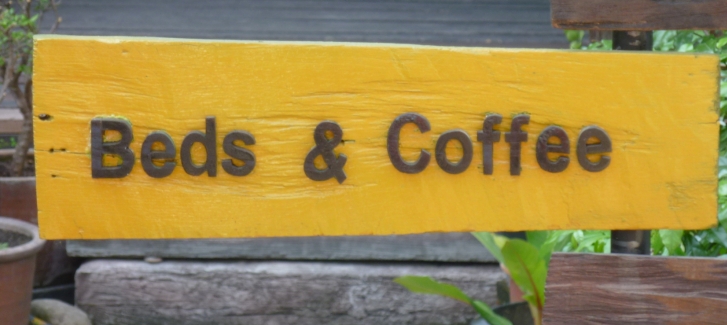
Is this for customers who are so tired they need a little nap before their coffee? Is it a bed and breakfast? Another sign, saying "spaghetti", only added to the mystery. There are lots of multifunctional places in Chiang Mai. Cafés where you can also get a massage are a dime a dozen. But it's also the first place I saw a combination laundromat and internet café. That seems like an obvious idea in retrospect! There are few things more dull than watching laundry spin around.
There are so many wats in Chiang Mai that we found a couple nice ones en route to our actual goal. For example, I saw some fiesty "moms" at Wat Umong Maha Thera Chan:
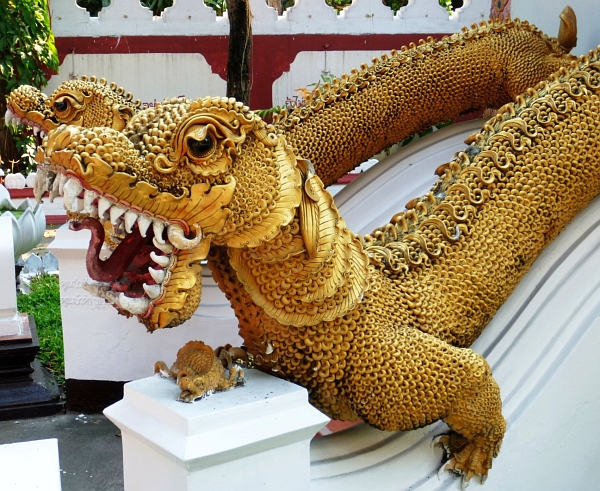
But finally we reached our goal: the oldest wat in Chiang Mai! Called Wat Chiang Man, this was built in 1297 AD on the spot that King Mangrai used a camp during the construction of his new capital city.
By this point it had cleared up, making it quite hot, but there was a beautiful blue sky to go along with the blue wihan of Wat Chiang Man:
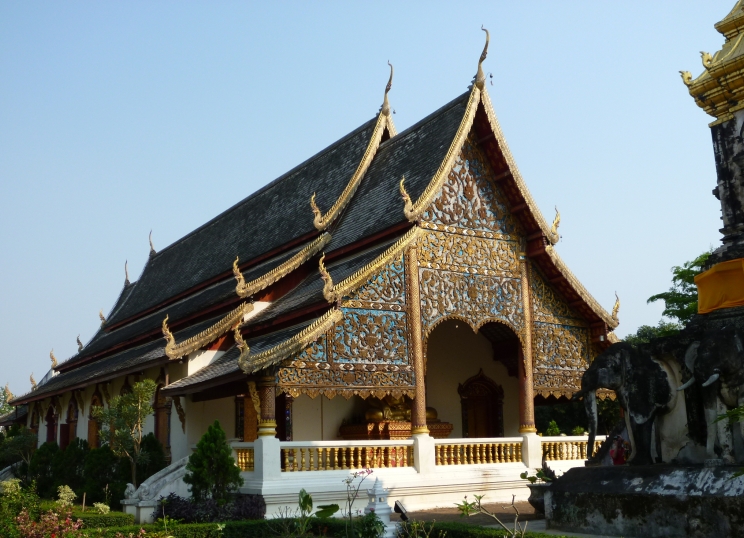
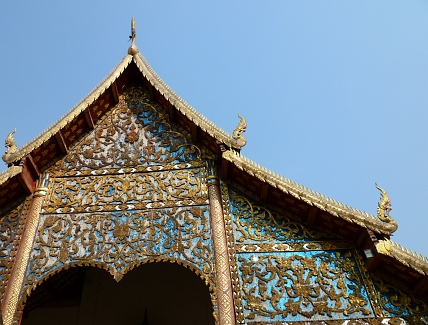
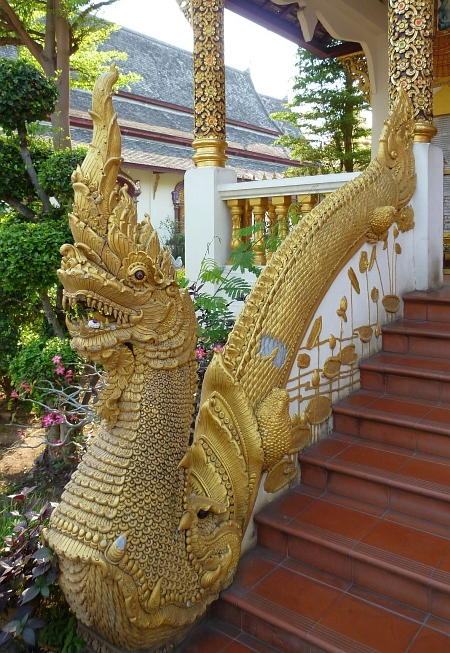

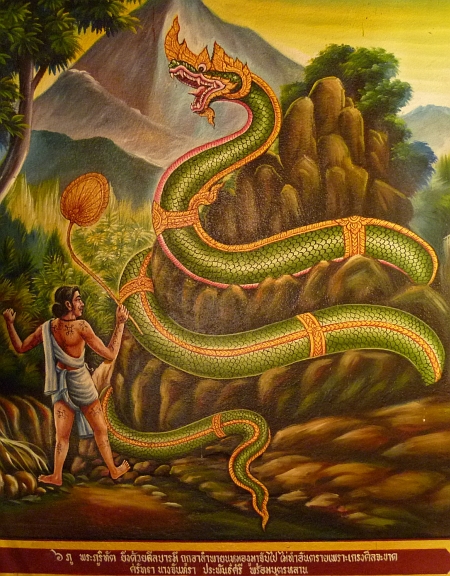
The last picture is one of a series illustrating Buddhist tales;
if you know Thai, please translate the caption and tell me what
it says!
At 4 pm, Ratchamondoen Road became an enormous market: the Sunday walking street market. When it got dark it became too crowded to be much fun, but it was nice at first. Thai street food is famous world-wide, and a detailed description would fill up all of this February diary — there are whole websites on this subject — so I won't even try!
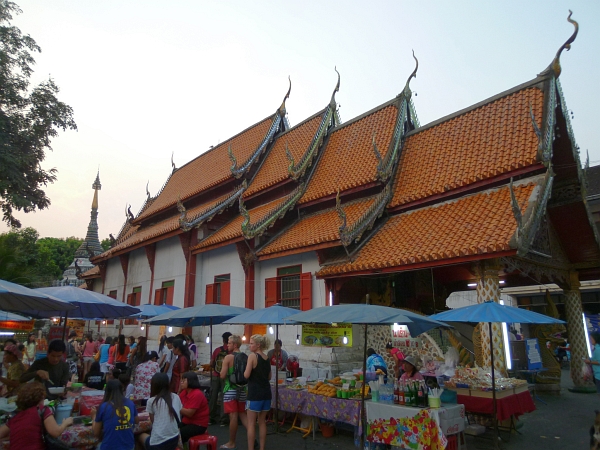
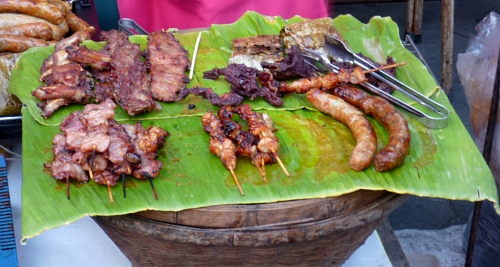
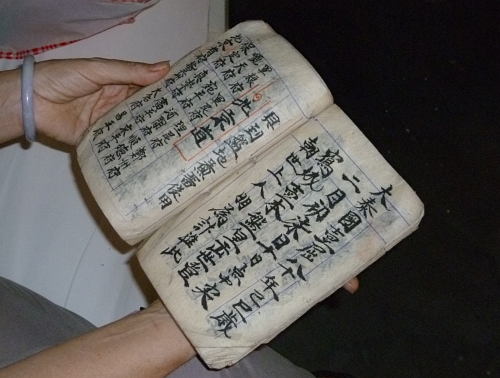
This is a Taoist text, written in classical Chinese — one of several Lisa bought today. It's yet another trace of the complex history of this area. In the 1800's, the Yao people were driven from China down into Vietnam and the Thai and Lao highlands. More fled to Thailand after the Vietnam War, since they were on the losing side. The Yao are Taoists, and in their struggle to scrape out a existence they sold many of their books to Thai antique stores back in the 1980's.
Lisa got these books at Kesorn Arts at 154-156 Tha Pae Road. That's a busy
street which heads east from the old city of Chiang Mai down to the
Ping River. It's a very old road, probably dating back to the city's
founding in 1296. Now it's lined with coffee shops, antique stores,
and small businesses. Kesorn Arts definitely worth visiting if you
like old stuff! The owner is knowledgeable and friendly.
February 22, 2012
Today we took a ride north out of the city, a bit closer to the Golden
Triangle, which is apparently a lot less dangerous now than in
former times, as the Thais at least have cracked down on opium
production, and a lot is now centered in Afghanistan.
First we went to Nam Tok Mae Sa, a picturesque park with a cascading stream. Then we went to the village of Samoeng, which wasn't picturesque at all... but they grow strawberries there, so we got some strawberries and strawberry juice. Then we stopped at Baan Tong Luang, an "eco-agricultural hill tribes village".
"Hill tribes" is a generic name for the smaller ethnic groups in southeast Asia. They don't necessarily love living in the hills: that's just where they were pushed when more powerful groups took over the flatlands! The groups living in this village include Yao, Karen, Hmong and others. It's a bit of a "human zoo", not very nice — but some are refugees from Burma, and this existence is probably quite a bit nicer than a refugee camp. They do, after all, have running water, food, accesss to schools, and ways to earn a living.
I forgot my camera today, so Lisa took all the pictures —
but the above photo of a Yao woman is from Wikipedia, taken
by "rex pe". Lisa is interested in the Yao because they're Taoist.
In my February 20 diary entry,
I showed you a Yao Taoist text.
Lisa had a bit of a cold so I did a bit of wandering on my own this
afternoon. On Tha Pae Road I explored Wat
Bupparam. It has some amazingly energetic-looking scaly creatures
called "moms" guarding the temple doors:
There's a lot to say about this trip that I didn't say, and a lot
to show you that I didn't show, but this will have to do for now!
I should emphasize that while I've shown you lots of pretty pictures,
Chiang Mai is, in parts, a gritty and bustling city, with some heavily
trafficked streets and a fair amount of smog mixed with the mist.
So if you go there, don't expect a romantic paradise.
It's still a wonderful place. When I arrived back in Singapore, it
seemed a bit dull.
February 23, 2012

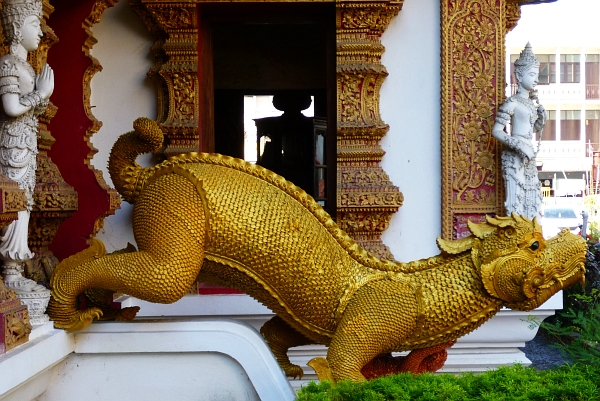
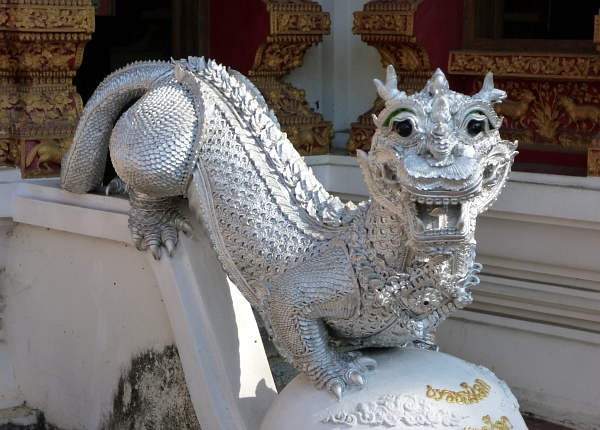
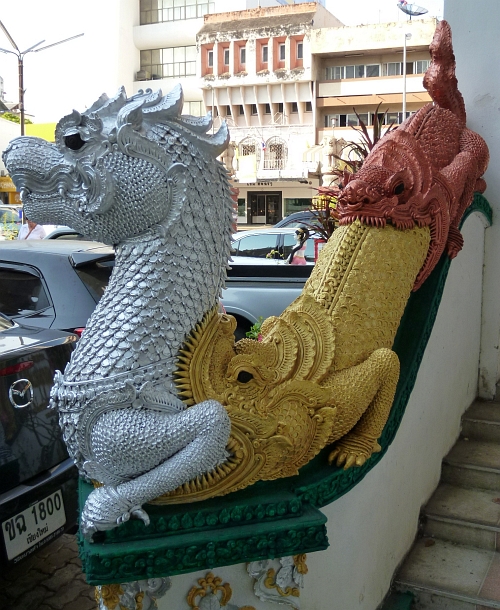
It also features a nice five-headed nāga, and makaras that double as
stair rails:
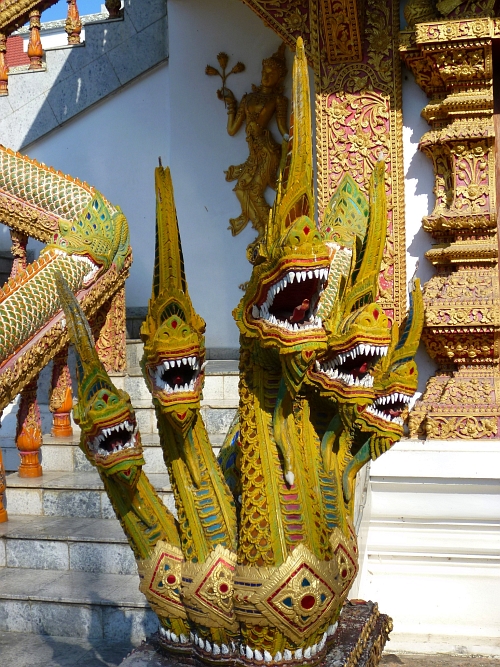
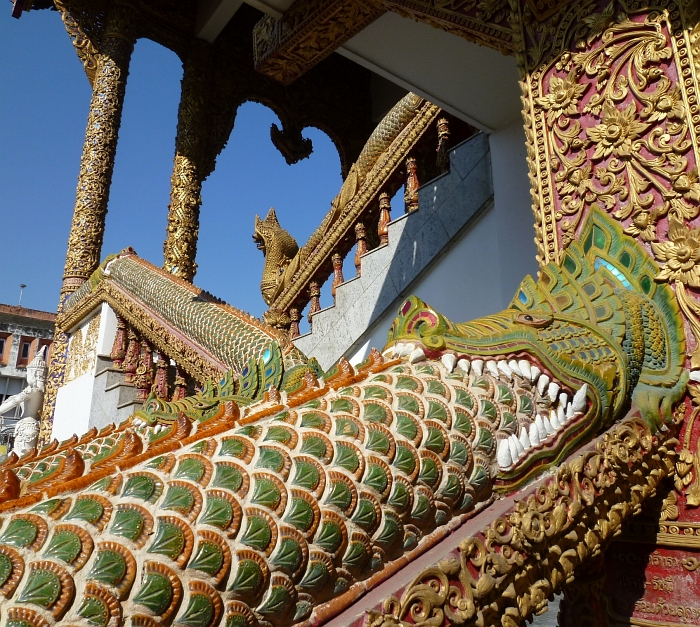
February 24, 2012
Lisa and I returned to Singapore today. Last night we finally broke
down and had a Thai massage... and realized we should have been doing
it every night! It really rejuvenated me, removing a lot of
stiffness that's been building up over the years.
For
my March 2012 diary, go here.
Among the legends relevant to the Buddha and the indigenous animist
serpent cult, one can rarely find any story which describes the Buddha
fighting against the Nagas as in the legends of Brahmanist
mythology. It is significant that Buddhism peacefully chooses an
associational path in harmony with the animist serpent cult, rather
than imposes its victory on the indigenous belief system. - Phan Anh
Tu
© 2012 John Baez
baez@math.removethis.ucr.andthis.edu